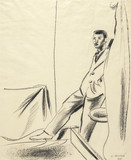The son of a French interior decorator, Louis George Bouché came naturally to art. As a young man he trained in Paris with Bernard Naudin (1876-1946) and at the Académie Colarossi and La Grande Chaumière. With the outbreak of World War I he and his mother returned to New York, where he studied for a year at the Art Students League. After serving in the navy, he became involved in modernist circles, sharing a studio with Alexander Brook (18981980) and obtaining Charles Daniels as his dealer. In 1915 Bouché began exhibiting at the Whitney Club and two years later showed at the first Salon of Independent Artists. His early cubist-inspired still lifes and interiors with figures are identified with his "Nottingham Lace Period," so named because of his propensity for including cheap lace curtains in most scenes. This attempt at glorifying bad taste and the seamier side of life was done almost tongue-in-cheek and revealed Bouché’s humorous, dadaesque view of the world around him. Bouché drastically changed his styles through out his career, but he never lost his wit.
After visiting Europe in 1921, he returned to New York, where he became director of the Belmaison Gallery of Decorative Arts in Wanamaker’s department store. While there he organized displays of both decorative art and contemporary French and American painting. About 1926 he gave up this position to begin working almost exclusively as a painter of murals in historical styles decorating private residences. He continued to paint murals throughout the 1930s, working at Radio City Music Hall and for the Pennsylvania Railroad Company, and he received two major commissions to decorate federal buildings in Washington, D.C. In 1936, with Allen Saalberg (born 1899) and Everett Henry (1893-1961) he formed a company to paint mural decorations.
In 1932 Bouché received a Guggenheim Fellowship, which enabled him to resume easel painting. He briefly came under the influence of Pablo Picasso (1881-1973) and Giorgio de Chirico (1888-1978). By the middle of the decade he had settled into his mature style, a realism in which scenes of everyday life are often painted from an unusual perspective and always with an appreciation of the paint medium. He taught at the Art Students League in New York, was a visiting professor in Cincinnati, Ohio, and Des Moines, Iowa, and in 1951 established his own art school with JOHN CARROLL in Chatham, New York. In 1953 he joined with REGINALD MARSH, Isabel Bishop (19021988), and other artists who wished to promote more "human" qualities in art rather than the then prevailing abstract expressionism in publishing several issues of Reality.
BIBLIOGRAPHY
Archiv. Am. Art, Louis Bouché Papers (portions on microfilm) § Index 20th Cent. Artists 3 (May 1936): 287-88; 3 (August-September 1936): I-II; reprint, pp. 585-86, 595-96 § Harry Salpeter, "Louis Bouché: Boulevardier of Art," Esquire 8 (November 1937): 70-71, 247-49 § "Louis Bouché," Life 11 (August 18, 1941): 48-50 § New York, Kraushaar Galleries, Louis Bouché (1896-1969), exh. cat., 1989, with essay by Jane Bouché Strong, biographical note, lists of exhibitions and collections.


